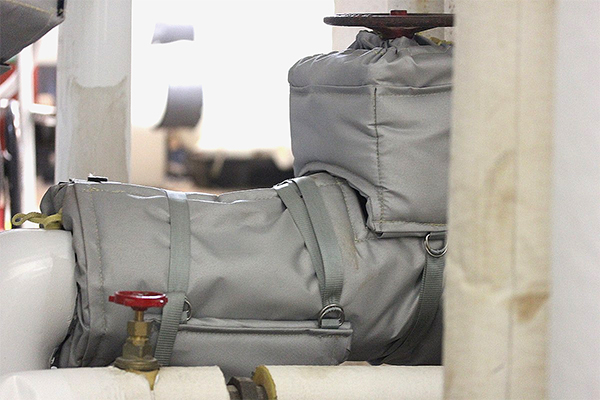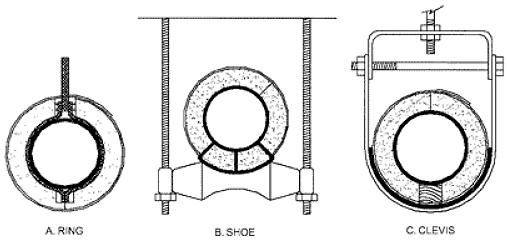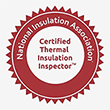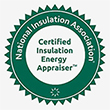Introduction
Within This Page
Mechanical insulation systems are defined as the materials and components used to insulate piping, equipment, vessels, ducts, and other types of mechanical items. Although important to facility operations and manufacturing processes, mechanical separation is often overlooked and undervalued. National standards, universal energy policies, or generally accepted recommendations as to what should be insulated, what insulation systems are acceptable for a specific use, and application best practices do not currently exist. As a result, the value of mechanical insulation is not being realized to its potential for energy conservation, reducing the dependency on foreign energy sources, improving the environment by reducing greenhouse gas emissions, improving global competitiveness, and providing a safer work environment for personnel and process.
Insulation is applied, but it is rarely engineered. With the best intentions, but not necessarily thorough knowledge, many specifications have evolved over the years primarily based on the modification of old documents. This practice-combined with the lack of education and awareness programs on the value of having a properly engineered, installed, and maintained mechanical insulation system-has led to the underutilization of mechanical insulation in energy conservation, emission reduction, process and productivity improvement, life-cycle cost reduction, personnel and life safety, workplace improvements, and a host of other applications.
Description
Whether someone is looking for basic insulation information or needs to design a complex insulation system, NIA's Mechanical Insulation Design Guide (Design Guide) is the best resource. Designed to assist the novice or the knowledgeable user alike in the design, selection, specification, installation, and maintenance of mechanical insulation, the Design Guide is continually updated with the most current and complete information.
Click to visit the Design Guide
Mechanical insulation is often used to limit heat gain or loss from operating at temperatures. However, there are far more reasons to use insulation on a project and that reason will impact the final insulation system design. Of course, insulating may be done to achieve multiple goals. Here are some common reasons.
-
Condensation Control: minimizing condensation and the potential for mold growth by keeping the surface temperature above the dew point of the surrounding air. This can also help avoid slip and fall hazards.
-
Energy Conservation—Financial Considerations: minimizing unwanted heat loss/gain from systems while minimizing the use of scarce natural resources and saving operational expenses.
-
Economic Considerations—Return on Investment: maximizing return on investment and minimizing the life-cycle cost.
-
Economic Thickness Considerations: considering the initial installed cost of the insulation system plus the ongoing value of energy savings over the expected service lifetime.
-
Environmental Considerations—Sustainability: minimizing the emissions associated with energy usage of projects.
-
Fire Safety: protecting critical building elements and slowing the spread of fire in buildings.
-
Freeze Prevention: minimizing energy required for heat tracing systems and/or extending the time to freezing in the event of system failure.
-
Personnel Protection—Safety: controlling surface temperatures to avoid contact burns (hot or cold).
-
Process Control: minimizing temperature change in processes where close control is needed.
-
Noise Control: reducing/controlling noise in mechanical systems.
In some projects, multiple design objectives must be satisfied simultaneously. For example, the objective may be to provide the economic thickness of insulation and to avoid surface condensation on a chilled water line. The chilled water line may pass through various spaces within the project. Since the various spaces may have differing temperature and humidity conditions, it is likely that different insulation materials, thicknesses, and coverings may be required for a single line. Because projects may involve many lines, operating at different service temperatures in various environmental conditions, it is clear that a systematic approach is required for all but the simplest projects.
Learn more about these design considerations and how to plan a project, or use the insulation design calculators at the Design Guide website.
Application
The design process for mechanical insulation systems entails developing answers to six basic questions: Why? What? Where? How? How to? and How much?
The Design Guide is divided into sections that answer each of these questions:
The Design Guide was created by the National Insulation Association to address these questions and includes information on the design, specification, installation, and maintenance of insulation systems used in the commercial and industrial sectors.
Design Guide Objective
The overall objective of the Design Guide is to identify, develop, and disseminate information related to mechanical insulation in commercial and industrial applications by examining current policies, procedures, and practices; identifying research or testing needs; developing recommendations utilizing the best science and information available; providing education and awareness programs as to the merits and value of properly designed, installed, and maintained insulation systems; and to establish a roadmap to implement improvements in insulation system design and selection; and establish application best practices. It is continually updated as deemed necessary and appropriate by the NIA to reflect current and state-of-the-art information.
Mechanical Insulation Market Definitions
Mechanical insulation encompasses all thermal, acoustical, and personnel safety requirements in:
- Mechanical piping and equipment, hot and cold applications
- Heating, Venting & Air Conditioning (HVAC) applications, and
- Refrigeration and other low-temperature piping and equipment applications.

Removeable blanket insulation
Image credit: Christopher Vella/Wikimedia Commons
Mechanical insulation in the Commercial Sector is defined to include systems used in education, health care, institutional, retail and wholesale, office, food processing, light manufacturing, and similar types of applications.
Mechanical insulation in the Industrial Sector is defined to include systems used in power, petrochemical, chemical, pulp and paper, refining, gas processing, brewery, heavy manufacturing, and similar types of applications.
Scope of the Design Guide
The scope of the Design Guide includes the design, specification, installation, and maintenance of insulation systems for use within the markets defined above. Specialized insulated air-handling products (flex-duct, duct liner, and duct board products) are not considered to be mechanical insulation in the context of this Design Guide and are not addressed.
The Design Guide is an evolving, online resource intended to provide architects, engineers, facility managers, project managers, etc. with design guidance, criteria, and technology for mechanical insulation systems. The Guide is continually updated with new information and is structured as a "vertical portal," enabling users to access increasingly specific information as they navigate deeper into the site.
Click here to access the Mechanical Insulation Design Guide.

Insulating Pipe Hangers
Image Credit: ©American Society of Heating, Refrigerating and Air-Conditioning Engineers, Inc.
Emerging Issues
Mechanical Insulation's Role in Carbon Reduction/ESG
Research and Data
Insulation Industry Opportunity Study
A coalition of trade associations, including the North American Insulation Manufacturers Association, the Insulation Contractors Association of America, the National Insulation Association, the American Chemistry Council (Plastics Division), and the Polyisocyanurate Insulation Manufacturers Association, commissioned a study that quantifies the benefits of completing insulation retrofit projects across residential, commercial, and industrial buildings and underlines the potential impact forward-thinking policies can have on decarbonizing the built environment. A press release, Executive Summary , full copy of the study , and webinar are available for reference.
A Study on Insulation's Positive Impact on Energy Efficiency and Emission Reductions
The National Insulation Association (NIA) and the Foundation for Mechanical Insulation Education, Training, and Industry Advancement commissioned—for the first time in the history of the mechanical insulation industry—a study to determine the impact mechanical insulation systems can have on reducing the demand for energy and greenhouse gas emissions. This analysis of high-service temperature ranges (150°F–800°F) examines and interprets an 11–year window of information.
For more information about this study please visit insulation.org/about-insulation/carbon-reductions/
Relevant Codes, Standards, and Guidelines
Building Codes and Specifications
It can be difficult to find information on mechanical insulation, so NIA members and staff have created and compiled the following free technical resources. NIA's Technical Information Committee (TIC) reviews and updates these documents quarterly.
To access NIA's codes and specification resources including the Insulation Materials Specification Chart and Guide to Insulation Product Specifications click here.
Government
The following are examples of commonly referenced government codes and standards:
- ASHRAE 90.1—Standard 90.1 has been a benchmark for commercial building energy codes in the United States and a key basis for codes and standards around the world for more than 35 years.
- ASTM—ASTM International is an international standards organization that develops and publishes voluntary consensus technical standards for a wide range of materials, products, systems, and services.
- International Code Council (ICC)—The ICC is dedicated to developing model codes and standards used in the design, build, and compliance process to construct safe, sustainable, affordable, and resilient structures. The International Codes®, or I-Codes®, published by ICC, provide minimum safeguards for people at home, at school, and in the workplace. The I-Codes are a complete set of comprehensive, coordinated building safety and fire prevention codes.
- MasterSpec—MasterSpec®, a product of the American Institute of Architects (AIA), is the ultimate resource for producing specifications your way. With master guide specifications, delete what does not apply, add customizations, and rest assured that the specs are current and complete.
- National Commercial & Industrial Insulation Standards Manual—The National Commercial & Industrial Insulation Standards Manual, also known as the MICA Manual, was developed by the Midwest Insulation Contractors Association (MICA). The newly updated 8th Edition is available both in printed and interactive PDF versions with 111 MICA Insulation Plates, including vapor dams and a new Cryogenic Section, and updated Materials Property Section with tables conforming to ASTM Standards.
- Process Industry Practices (PIP)—Process Industry Practices (PIP) is a coalition of process industry owners and engineering construction contractors who serve the industry. PIP was organized in 1993 and is a separately funded initiative of the Construction Industry Institute (CII), at The University of Texas at Austin. PIP publishes documents called Practices. These Practices reflect a harmonization of company engineering standards in various disciplines. One of these disciplines is coating and insulation and includes design, selection and specification, and installation information. Visit www.pip.org to learn more.
- UL's Product iQ®—UL's Product iQ allows users to quickly find, specify, or verify UL-Certified products for projects. Visit it at https://productiq.ulprospector.com/en
Additional Resources
NIA has a vast collection of technical resources about mechanical insulation and the general insulation industry.
Glossary of Mechanical Insulation Terms: This extensive glossary can help make sense of even the most technical insulation jargon. Click here to access the glossary.
Insulation Outlook Magazine: An award-winning publication, Insulation Outlook® is the only international magazine devoted exclusively to industrial and commercial insulation applications, products, and materials. It is free for engineers, specifiers, mechanical contractors, and insulation end users. For subscription information, click here. To access Insulation Outlook's article database, click here.
Insulation Products and Providers: For the most up-to-date information on how to use or install insulation products or accessories, it is best to reach out directly to the experts. For contact information on NIA member companies, click here.
MICA's National Commercial & Industrial Insulation Standards Manual: The National Commercial & Industrial Insulation Standards Manual was developed by the Midwest Insulation Contractors Association (MICA) to serve as a useful resource for commercial and industrial insulation professionals. Widely accepted as the industry standard, the manual is a must-have guide for contractors, engineers, architects, and specifiers. For more information about the MICA National Commercial & Industrial Insulation Standards Manual, click here.
NIA's Online Store: NIA is committed to delivering access to top products and services that provide technical resources, increase industry awareness, and improve worker safety. If a specific product cannot be found, please contact products@insulation.org. To access NIA's online store, click here.
Education and Training
NIA is committed to industry advancement and offers access to a variety of training opportunities and online tools for NIA members and non-members. The resources listed below are designed to advance a business and increase industry and technical knowledge.
NIA's Education Center: NIA's Education Center is a new concept in training and education for the insulation industry to meet the growing need for easily accessible, on-demand training from a trusted industry source. With more than 30 topics in development, it will be the go-to national resource for information and training tools specifically designed for anyone who is involved in the mechanical insulation industry.
Free Industry Resources—Available to everyone through the Education Center.
- Insulation Materials Specification Chart
- Guide to Insulation Product Specifications
- Insulation Science Glossary
- Mechanical Insulation Design Guide
- Insulation Calculators
For information about the NIA Education Center email training@insulation.org. To explore the NIA Education Center, click here.

NIA's Thermal Insulation Inspector Certification: NIA's Thermal Insulation Inspector Certification Program, a two-part, four-day course to educate insulation inspectors on how to evaluate installation work and determine whether it is compliant with mechanical insulation specifications.
NIA Certified Thermal Insulation Inspector Benefits
This certification program provides education on mechanical insulation, how to verify that the insulation is being installed to the specification, and how to identify potential areas of concern during initial installation or ongoing operations. This certification-level course is designed for experienced insulation professionals ready to learn a new specialty and companies ready to offer insulation system inspection as part of their services. The course is beneficial for anyone who has responsibility for contracts, maintenance, business development, quality assurance (QA)/quality control (QC), project oversight, safety, inspections, estimating, management, product development, mechanical insulation system design, and specification development. For more information about NIA's Thermal Insulation Inspector Certification program, click here. To find a Certified Thermal Insulation Inspector, click here. For a list of insulation inspector program FAQs, click here.

NIA's Insulation Energy Appraiser Certification: The Insulation Energy Appraisal Program™ (IEAP) is a 2–day course that teaches students how to determine the optimal insulation thickness and corresponding energy and dollar savings for a project. The program was designed to teach students the necessary information to give facility managers a better understanding of the true dollar and performance value of their insulated systems.
During the course students will learn how to conduct a facility walkthrough; use the 3E Plus® software; utilize infrared cameras during inspections; understand steam efficiencies; analyze and complete an appraisal spreadsheet; and present a customer with a final report that outlines the potential savings and emission reductions that mechanical insulation can provide. If interested in taking the IEAP course, email training@insulation.org for more information.
Certified Appraisers: Students who pass the certified course exam become Certified Insulation Energy Appraisers™. The certification is valid for 3 years, after which the individual must recertify. After passing the exam, students will receive a certificate, lapel pin, and marketing kit. The marketing kit includes the official copyrighted Certified Insulation Energy Appraiser™ logo to promote their certification to clients. For more information about NIA's Insulation Energy Appraiser Program, click here. To find a Certified Thermal Insulation Inspector, click here.








